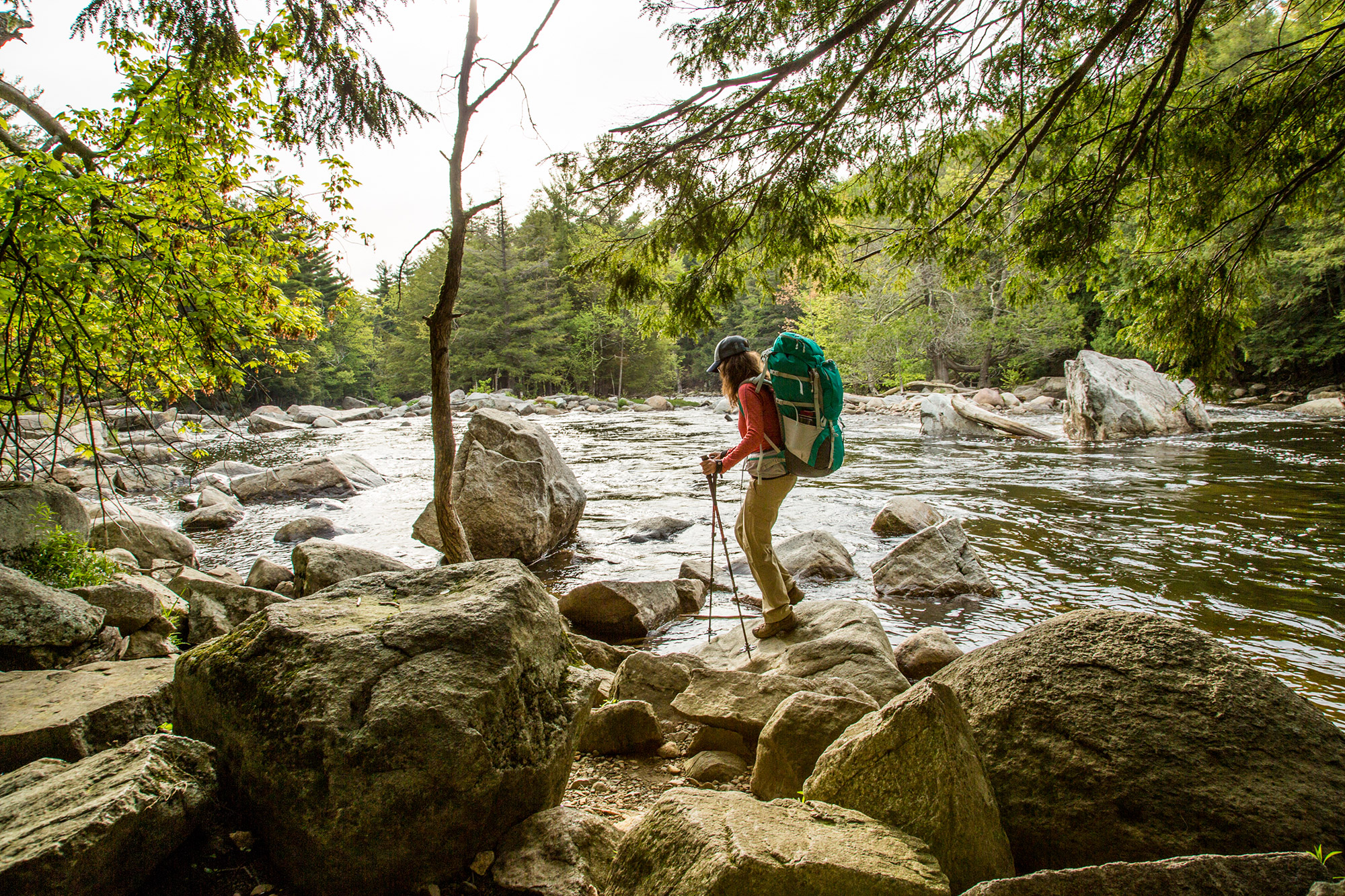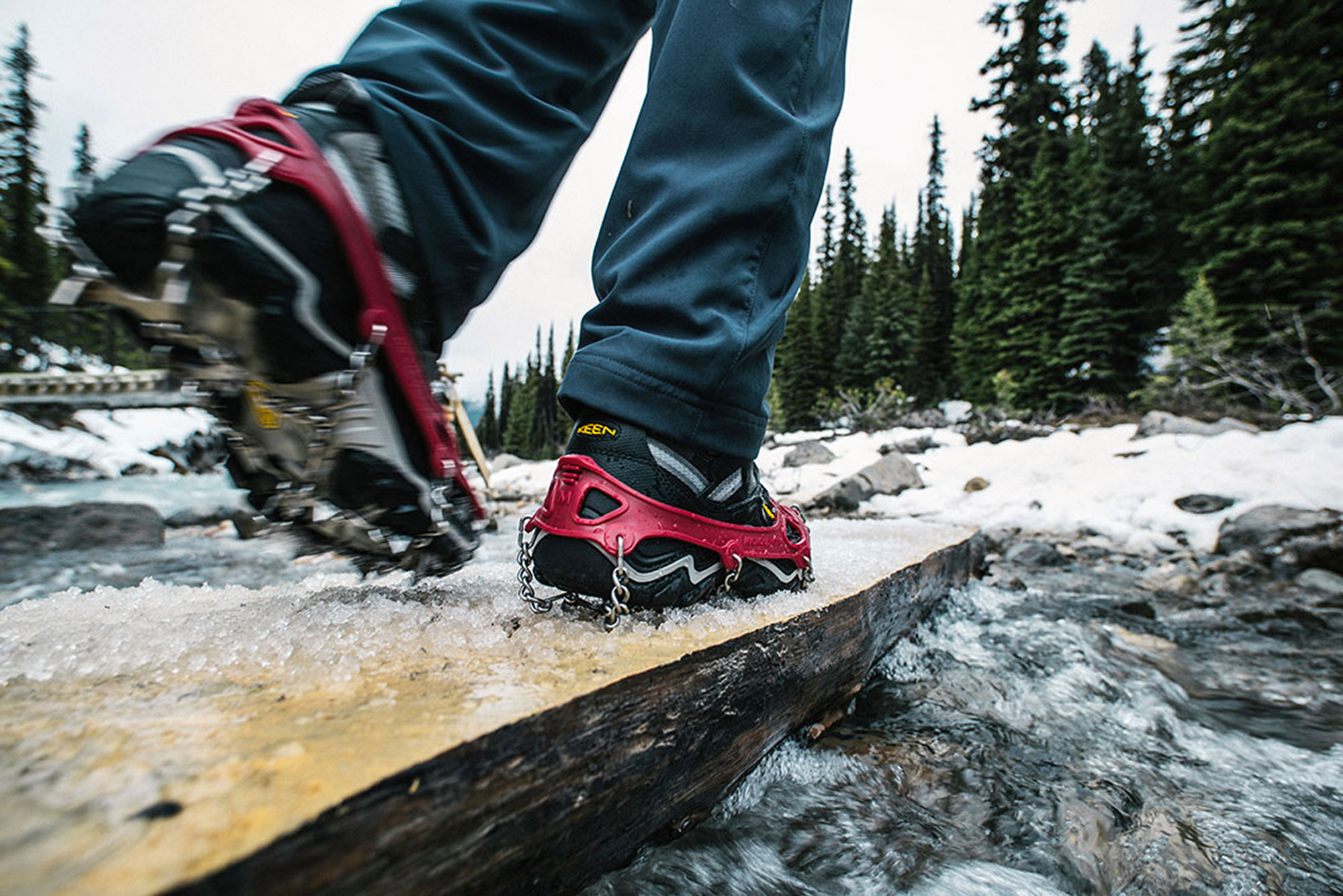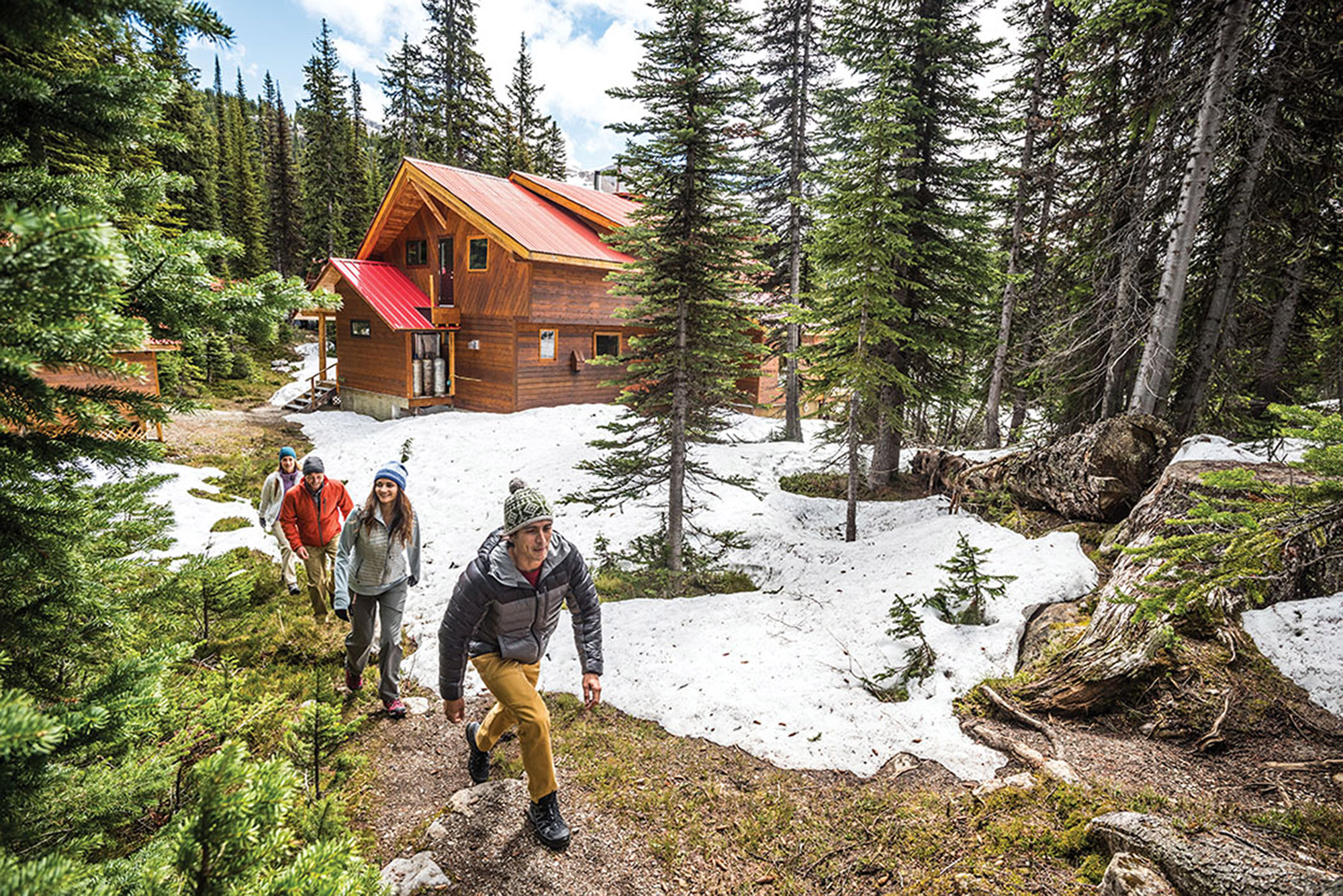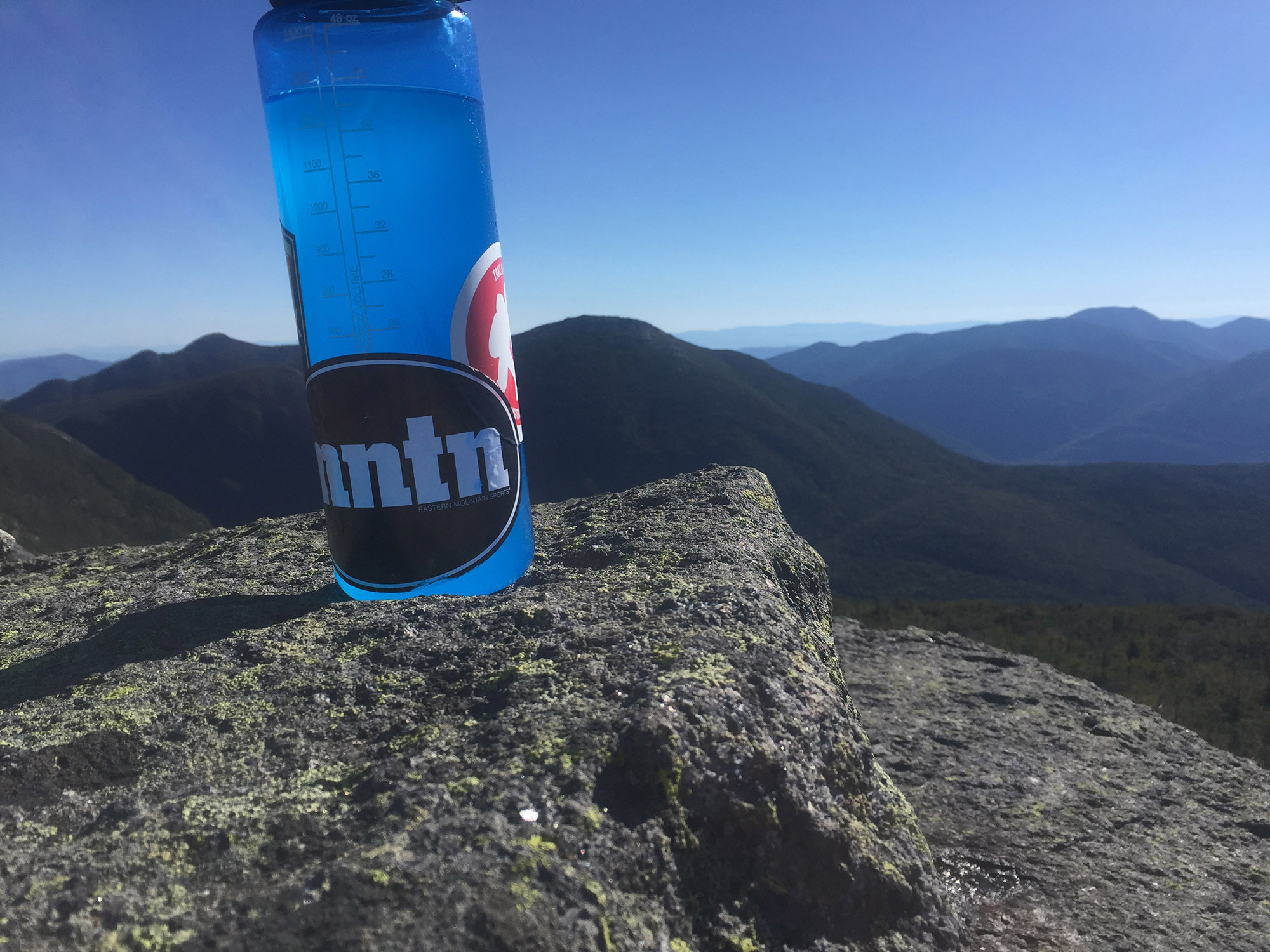As the seasons transition from summer to fall in the White Mountains, so do the contents of our hiking kits. To deal with the shorter days, colder temperatures, and potentially icy and snowy trails, it’s important to emphasize layering, having the proper footwear, and carrying enough group gear to deal with any emergency.

Upper Body Layers
Our usual fall base layer is a sun shirt, like the Black Diamond Alpenglow Sun Hoody. Although the sun might not be as strong this time of year, you can still get a burn above treeline. And, when the sun goes behind a cloud, the hood and long sleeves are great for keeping the chills at bay.
A lightweight wind shirt, like the Mountain Hardwear Ghost Lite, is another year-round staple. It’s perfect for the beginning of cool morning hikes and helps keep you warm as you battle breezes on exposed ridges and summits. And, since they’re so lightweight and packable, there’s absolutely no reason not to have one with you.
Whether or not rain is in the forecast, we also pack a raincoat. Getting soaking wet when air temperatures are low is a recipe for an epic survival story or worse. With Gore-Tex construction, jackets, such as the Marmot Minimalist (Men’s/Women’s), will keep you dry in whatever you encounter, without eating up too much pack space.
Fall also marks the unofficial start of puffy coat season. We like to carry two separate puffers, with one being a lightweight or hybrid offering, like the Arc’teryx Atom SL Hoody (Men’s/Women’s), and the other a more traditional midweight piece, such as the Black Diamond Access Hoody (Men’s/Women’s). On cold or windy days, we typically don the lighter and more breathable one just below treeline to keep us warm on the final push to the summit. And, while enjoying the views from the top, we then pull on the other, warmer one. With little weight penalty for carrying two extremely packable, insulating pieces, hikers gain versatility in their layering and better adapt to the conditions facing them.
Lower Body Layers
A lightweight and stretchy soft shell pant, like the Marmot Scree (Men’s/Women’s), delivers the needed mobility and protection for fall pursuits. Pair them with an inexpensive and reliable waterproof rain pant, like the EMS Thunderhead (Men’s/Women’s), to stay dry in the event of inclement weather.
Typically during the fall, if you keep your core warm, you may not need to add a base layer to your lower body. However, if you run cold, the weather looks frigid, or you like to linger, consider wearing something lightweight.

Footwear and Trekking Poles
Nothing ruins a trip faster than cold feet, and there is no surer way to get them than having inferior footwear. Fall hikers encounter everything from rain to snow and ice, so having a good pair of waterproof footwear is imperative. And, because you may encounter early-season snow, we prefer the extra protection afforded by waterproof boots. The Asolo Fugitive GTX has been a long-time staple of many hikers’ kits, but if you can, stop by a store to try a few different pairs on first. From Oboz to Scarpa to Salomon, EMS is sure to have something that feels just right. A good, comfortable fit is the most important feature of all. Without it, you’re unlikely to even put the boots on.
It’s not just boots that get an upgrade, however. We also move to a heavier sock, going from sneaker-friendly options, like the Smartwool PhD Outdoor Light Mini, to a more classic option, like the Smartwool Light Hiking Sock.
Another important addition is a traction device. It’s common to encounter icy sections this time of year, especially when you’re traveling above treeline or at higher elevations. Kahtoola MICROspikes deliver all the grip you need, are proven to last through years of hard service, and easily transition from a fall just-in-case item to a winter must-have.
Trekking poles are also handy, providing extra stability while you navigate everything from slick leaves to the Whites’ icy fall terrain. We’ve both spent years using the Black Diamond Traverse Ski Poles and have found them inexpensive, durable, and up to the task of hiking New England’s tallest peaks. Equally important, they transition nicely into ski season when the trails finally fill with snow.
Accessories
For fall hikes, we typically bring multiple pairs of lightweight gloves, along with one heavier pair of gloves or mittens for the summit. We’ve found a good blend starts with a lightweight, stretchy fleece glove, like the EMS Power Stretch, for getting ready and being on the trail. As well, we include something more robust, like a leather work glove or softshell glove—the Black Diamond Dirt Bag is an excellent example—for above-treeline or more wintery conditions. For summits and emergencies, we also carry a warm mitten, like the EMS Summit, and a package or two of handwarmers.
One of the easiest ways to regulate your temperature is through your head. Because of this, it’s nice to bring two hats on fall hikes: a lighter, baseball-style cap for when we are moving quickly below treeline, and a more traditional winter hat—the Smartwool Cuffed Beanie is a longtime favorite—for when you are exposed to the elements. As one of the great things about layering with hoods, making adjustments to your head’s protection on the fly easily lets you warm up or cool down.
In the fall, we also like to carry either a buff or a balaclava, and sometimes, we even pack both. Buffs are incredibly versatile, ideal for everything from an impromptu hat to a neck scarf to a facemask. In late fall or on particularly cold, windy days, however, there’s no substitute for a high-quality balaclava, such as the Black Diamond Dome.

Bladder to Bottles
Hydration bladders are great for ensuring you drink enough water in the heat of summer. But, by fall, they pose some challenges, especially late in the season. For example, the bladder’s exposed parts, like the tube and the mouthpiece, have potential to freeze, which makes for a long, thirsty day. Instead, most hikers carry traditional Nalgene wide-mouth water bottles. If the weather does look cold, on the other hand, supplement a water bottle with a Hydro Flask thermos of your favorite hot beverage.
Just In Case
Although spending an unexpected night in the woods is never fun, the consequences increase as daylight hours shorten. Whether it is due to an injury or just getting lost, or to cope with colder nighttime temperatures and potentially wet and icy ground, we carry a lightweight bivy and a Sea to Summit Ultralight Pad to offer some insulation. All the extra layers mentioned above, including the double puffies, multiple hats, heavy mittens, and handwarmers, also come in handy here.
The Pack
You’ll need to have a little more space to carry the additional cool-weather items. However, don’t let a stuffed backpack prevent you from keeping anything vital behind. With plenty of space and lightweight construction, the Osprey Talon 33 is perfect for carrying all your needs—and a few of your wants—on your next fall hike.
Not every item listed above is essential to hiking one of the Northeast’s 4,000-footers this fall, but having the right combination can make your experience safer and more enjoyable—not to mention more efficient. The best advice, though, is to get outside and discover what works for you. If you have a key piece of fall hiking gear, tell us about it in the comments!
Tim Peck and Doug Martland
Tim and Doug met long ago at the Eastern Mountain Sports in Canton, Massachusetts. Bonding over a love of slick Quincy Quarry granite, White Mountain sufferfests, and scheming up adventures while folding tee-shirts, today Tim and Doug collaborate to write about their favorite outdoor activities and occasionally get nostalgic about tee-shirt tables.





